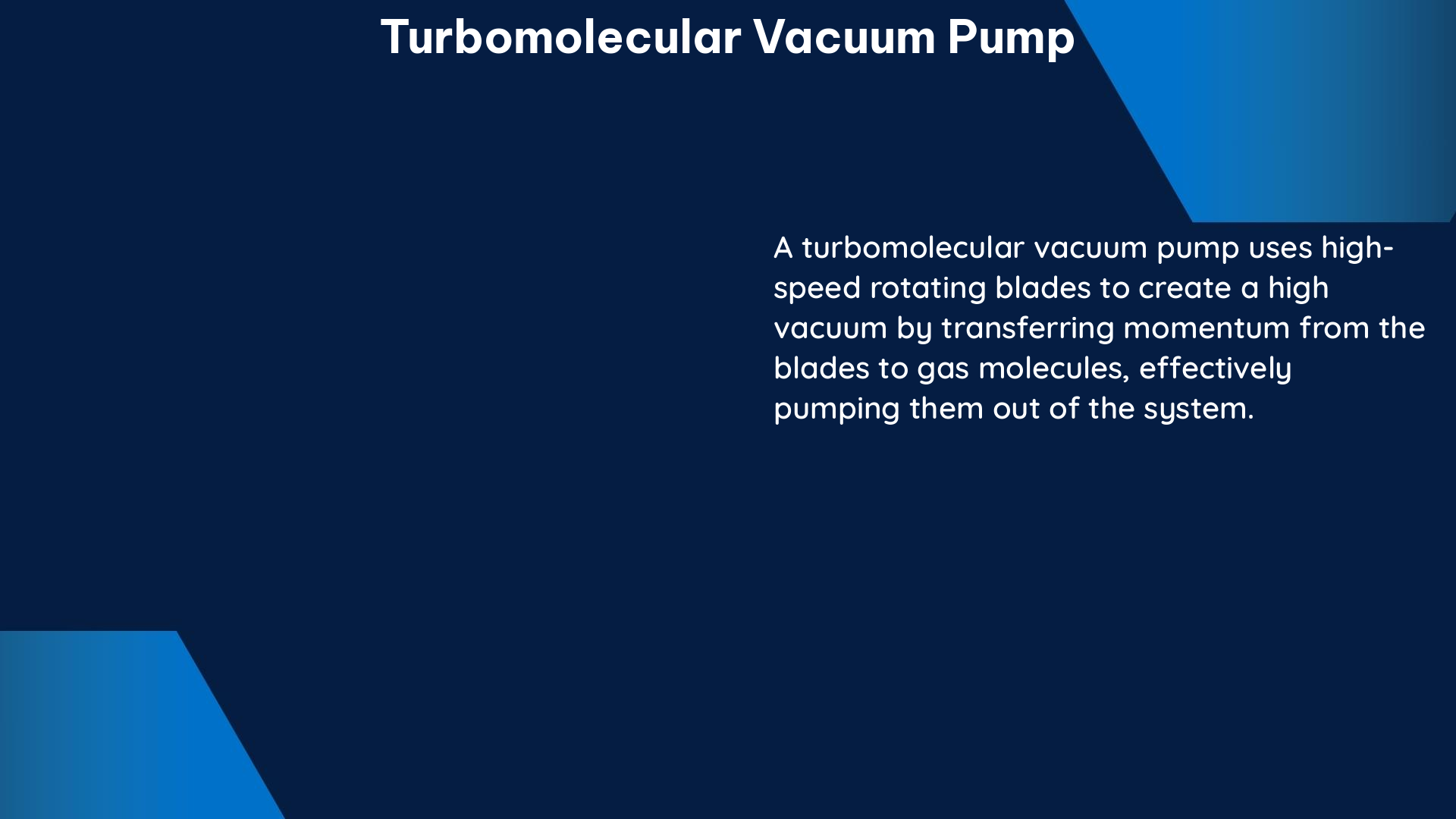Turbomolecular vacuum pumps are high-performance pumps used to generate clean high and ultra-high vacuum conditions, typically in the range of 10^-3 to 10^-11 mbar. They are commonly used in analytical instruments such as mass spectrometers, electron microscopes, and surface analysis instruments that require adequate high vacuum conditions for operation.
Understanding Turbomolecular Vacuum Pumps
Turbomolecular vacuum pumps work on the principle of momentum transfer, where the rotating blades of the pump impart momentum to the gas molecules, causing them to be expelled from the pump. This process is highly efficient, allowing these pumps to achieve extremely low pressures.
Pumping Speed and Compression Ratio
The pumping speed of a turbomolecular vacuum pump, which is the volume of gas that the pump can move per unit time, depends on the version of the pump and the type of gas being pumped. For example, the pumping speed for nitrogen (N2) on a Type 011 pump is 2 x 10^-11 m^3/s at a partial pressure of 791 mbar, while the pumping speed for water vapor (H2O) on the same pump is 5.3 x 10^-10 m^3/s at a partial pressure of 23 mbar.
The compression ratio of a turbomolecular vacuum pump is the ratio of the inlet pressure to the outlet pressure and indicates how well the pump can compress gases. For air, the compression ratio is approximately 30 for a single pump stage and can be much higher (> 10^12) for multiple stages.
Pump Design and Operation
Turbomolecular vacuum pumps use rotating and fixed disks with oblique channels to generate a compression effect, with the rotor disk channels arranged in mirror image to the channels on the stator disks. A rotor disk together with the stator disk forms a pump stage that generates a particular compression ratio.
The pumping speed and compression ratio of a turbomolecular vacuum pump depend on the rotation speed of the blades, the intake flange area, and the inlet conductance value from the measuring dome and flange. The pumping speed is approximately proportional to the rotation speed of the blades and the intake flange area, while the compression ratio is determined by the design of the pump stages and the number of stages used.
DIY Turbomolecular Vacuum Pump

Building a turbomolecular vacuum pump from scratch would require advanced knowledge of vacuum technology and mechanical engineering. It would involve designing and manufacturing the pump casing, rotor and stator disks, and drive electronics, as well as assembling and testing the pump to ensure it meets the required specifications for pumping speed and compression ratio.
Design Considerations
Some key design considerations for a DIY turbomolecular vacuum pump include:
- Pump Casing: The casing must be designed to withstand the high rotational speeds and pressures involved, typically made from materials like stainless steel or aluminum.
- Rotor and Stator Disks: The disks must be precisely machined with the correct oblique channel patterns to achieve the desired compression ratio.
- Drive Electronics: The pump requires a high-speed motor and control electronics to maintain the necessary rotational speed, typically in the range of 20,000 to 90,000 RPM.
- Bearings and Lubrication: The pump’s bearings must be designed to operate at high speeds and under high vacuum conditions, often using specialized lubricants.
- Vacuum Sealing: Proper sealing of the pump’s inlet and outlet flanges is crucial to maintain the desired vacuum levels.
Challenges and Considerations
Building a turbomolecular vacuum pump from scratch is a complex and challenging task that requires a deep understanding of vacuum technology, materials science, and mechanical engineering. Some additional considerations include:
- Achieving the required pumping speed and compression ratio for the intended application
- Ensuring the pump’s reliability and long-term operation under high-stress conditions
- Designing the pump’s cooling system to dissipate the heat generated by the high-speed rotation
- Integrating the pump with the rest of the vacuum system, including the necessary control and monitoring systems
Overall, while a DIY turbomolecular vacuum pump is possible, it is a highly specialized and technical endeavor that is typically reserved for experienced vacuum system engineers and researchers.
References:
- Global Turbomolecular Vacuum Pumps Market Size and Share … (n.d.). Retrieved from https://www.linkedin.com/pulse/global-turbomolecular-vacuum-pumps-market-size-share-evaluation-nzlxf/
- High Vacuum Pumps Turbomolecular Pumps TURBOVAC … (n.d.). Retrieved from https://www.leyboldproducts.com/media/pdf/c5/88/98/CP_040_TURBOVAC_MAG_EN.pdf
- Pumping Speed Measurement and Analysis for the Turbo Booster … (n.d.). Retrieved from https://www.researchgate.net/publication/26406133_Pumping_Speed_Measurement_and_Analysis_for_the_Turbo_Booster_Pump
- Working with Turbopumps (n.d.). Retrieved from https://mmrc.caltech.edu/Vacuum/Pfeiffer%20Turbo/Turbos.pdf
- Turbomolecular Vacuum Pump. Used to draw high vacuums in vapor deposition machines and other cases. Looks like a mini jet engine. (2020, April 15). Retrieved from https://www.reddit.com/r/Skookum/comments/g1qsj4/turbomolecular_vacuum_pump_used_to_draw_high/

The lambdageeks.com Core SME Team is a group of experienced subject matter experts from diverse scientific and technical fields including Physics, Chemistry, Technology,Electronics & Electrical Engineering, Automotive, Mechanical Engineering. Our team collaborates to create high-quality, well-researched articles on a wide range of science and technology topics for the lambdageeks.com website.
All Our Senior SME are having more than 7 Years of experience in the respective fields . They are either Working Industry Professionals or assocaited With different Universities. Refer Our Authors Page to get to know About our Core SMEs.